Scottish hydrogen: assessment report
Examines how applications of hydrogen-based technologies in transport, industry, heat and whole system approaches can best be deployed in Scotland.
2 The Global Picture for Hydrogen
2.1 Global action
Momentum is building internationally for hydrogen to play a key role in a future decarbonised energy system. Within Europe and globally, nations are developing hydrogen strategies and policy frameworks, to set out their national ambitions. These are generally supported by targets and clear plans for action, which are summarised in Table 2.
Scotland is not alone in pursuing hydrogen but has been at the forefront of hydrogen demonstration and development. In order to maintain that position in a fast-moving global market, it is critical that action is taken to set clear and ambitious targets and policy frameworks for the sector, that are aligned with its natural capital and unique strengths.
Globally a range of actions have been undertaken to support the hydrogen economy. Some have included supporting demonstration projects, to provide the evidence base to de-risk commercial deployments. Others have provided wider market support, to enable commercial deployment at scale. The last decade has seen a significant expansion of activity and projects in the hydrogen sector. Activity is particularly clustered around South East Asia and Europe, although there is interest in the US and elsewhere. Figure 7 and Figure 8 show a selection of global and European hydrogen projects respectively.
"Those with the most developed industrial economies such as Japan and Germany have a clear lead in traditional hydrogen applications such as refining, steelmaking, steelmaking, chemical processes etc"
Stakeholder questionnaire opinion
Table 02: Summary of international hydrogen strategies
European Union[13] (Strategy Released July 2020)
Targets and commitments
6 GW of green hydrogen electrolysers by 2024, and min. 40 GW by 2030
European Clean Hydrogen Alliance to facilitate the strategy actions and build an investment pipeline.
Fuel Cells and Hydrogen Joint Undertaking (FCHJU) drives a funding scheme (€1.3 billion (bn)) to accelerate hydrogen technologies in energy and transport[14].
Key Drivers
Decarbonisation
European Green Deal call under Horizon 2020 (Q3 2020). Just Transition alignment
Enables renewable energy development
Mix of green and blue hydrogen production.
Green hydrogen is the priority, with blue hydrogen needed in the interim.
Challenges Identified
International policy commitments
Large scale system integration and cooperation
Requires critical mass in investment
Germany[15] (Strategy Released June 2020)
Targets and commitments
5 GW of green hydrogen generation by 2030.
€7 bn to ramp up "home market" and a further €2 bn to invest in partner country production.
Key Drivers
Green decarbonisation
Focus on green hydrogen production, but recognise a EU market for blue hydrogen as transition.
Challenges Identified
Domestic hydrogen production (drives needs for imports) and cross-border collaboration
Negative public opinion on blue hydrogen production.
Norway[16] (Strategy Released June 2020)
Targets and commitments
Increase the number of pilot and demonstration projects. Focus on transportation and industry.
ENERGIX- programme grant of NOK 120 million (m) (€11 m*). Hydrogen technologies have central role in the programme.
Key Drivers
Decarbonisation
Economic value creation
Mix of green and blue hydrogen production.
Challenges Identified
Targets relying on technological progress
Netherlands[17] (Strategy Released March 2020)
Targets and commitments
Hydrogen programme to develop 3-4 GW of electrolyser capacity by 2030.
NortH2 vision launched in February 2020 which intends to produce green hydrogen from offshore wind, growing to 10 GW in 2040[18].
€35 m/year Climate Budget Fund, some of which will be allocated to support scaling up operating costs of various technologies, including hydrogen related ones.
Energy Innovation Demonstration Scheme- maximum of €15 m per project of which hydrogen projects are eligible.
Renewable energy subsidy scheme that includes hydrogen production via electrolysis (maximum €300/tonne (tn) produced)
Key Drivers
Decarbonisation
Large wind energy resource including offshore
Transition away from natural gas production
Mix of green and blue hydrogen production
Challenges Identified
Decarbonising current grey hydrogen production supplying industry
Setting up a hydrogen supply chain to capture economic benefits
Australia[19] (Strategy Released November 2019)
Targets and commitments
Targeting exports to Asia. Phase 1 (underway to 2025) focused on demonstrations. Phase 2 large scale market activation (2025 onwards).
Government has already committed over AU$146 m (€88 m*) to hydrogen projects along the supply chain. Regional boosts e.g. AU$15 m (€9 m*) Hydrogen Industry Development Fund in the Queensland Hydrogen Strategy.
Key Drivers
Large scale wind and solar resources.
Opportunity to export hydrogen to Japan and Korea.
Decarbonisation of indigenous heavy industry and heavy transport.
Focus placed predominately on green hydrogen production.
Challenges Identified
Demonstrating the safety case.
Development of early demand.
South Korea[20] (Roadmap released 2019)
Targets and commitments
Focused on transportation. Target of 6.2 m fuel cell vehicles (FCV) and 1,200 refuelling stations by 204021
In 2018 the Ministry of Trade Industry and Energy (MOTIE) announced US$ 22 bn (€18.5 bn*) budget for establishment of a hydrogen vehicle industry22
Key Drivers
Economic opportunities in automotive manufacturing.
Mix of green and blue hydrogen production.
Challenges Identified
Planned rapid increase in demand, low capability for indigenous production.
Japan[23,24] ('Basic' Hydrogen Strategy, 2017)
Targets and commitments
Focused on transportation due to large automotive manufacturing industry. Target of 800,000 FCVs by 2030.
Olympic village has 6,000 residential units supplied exclusively by hydrogen, through combined heat and power fuel cell.
The Japanese government have previously dedicated US$1.5 bn (€1.27 bn*) to hydrogen technology research and development (R&D).
Key Drivers
Current reliance on fossil fuel imports
Energy security
Shift away from nuclear following Fukushima disaster
Decarbonisation
Automotive manufacturing capability
Mix of green and blue hydrogen
Challenges Identified
Economic efficiency related to cost competitiveness of hydrogen technologies and competing automotive hydrogen markets.
China25 (No strategy released)
Targets and commitments
Focused on transport applications. Target of 1 m FCVs by 2030 and 1,000 refuelling stations.
Recently announced construction start of world's largest solar powered hydrogen plant in Nigxia Hui[26].
Key Drivers
Decarbonisation.
Competitiveness in automotive manufacturing.
Improving air quality.
Mix of green and blue hydrogen.
Challenges Identified
Lack of domestic resource to create components used in hydrogen technology e.g. fuel cells, electrolysers.
USA[15] (Strategy Released July 2020)
Targets and commitments
Focused around fuel cells for transportation and power. E.g. the California Hydrogen Highway, one of the largest refuelling networks globally.
Key Drivers
Decarbonisation.
Support manufacturing industries.
Mix of green and blue hydrogen.
Challenges Identified
Cost efficiency.
Safety case development and lack of public awareness.
Institutional barriers.
2.2 A global commodity market
As with all energy resources markets appear through energy imbalance. Countries with abundant resources relative to demand have the potential to be net exporters e.g. Australia, Scotland, and vice versa will be importers e.g. Germany. Hydrogen could be a global energy commodity, acting as an energy carrier, with strong analogies to the existing global O&G market.
For a country to be a successful exporter of hydrogen, it must be able to produce and transport the hydrogen to the point of demand. This must be done in a cost competitive way, competing in a global market. Access to low cost renewables, supplies of natural gas, carbon storage infrastructure, utilisation of existing transport infrastructure and proximity to demand, will all contribute to reducing the cost base.
The international hydrogen commodity market is in its infancy but could develop rapidly. For example, energy scarce Japan has secured hydrogen supplies from Australia for the Tokyo 2021 Olympics.
Scotland is well placed in terms of proximity and infrastructure connectivity to several European import nations, such as Germany, Italy, the Netherlands, Belgium and Sweden. These countries are unlikely to be able to decarbonise wholly through their indigenous wind and solar renewable energy supply. Scotland also has potential to produce significant quantities of green hydrogen from an offshore wind resource, which is vastly greater than its indigenous demand. However, competition is expected from regions such as the Middle East and southern Europe where very cheap solar electricity has the potential to create very low cost green hydrogen.
Estimates of the scale of the global market vary and will ultimately depend on the level of penetration of hydrogen within the energy system. Figure 6 shows a range of predicted demand level in 2050 globally, in Europe and in the UK.
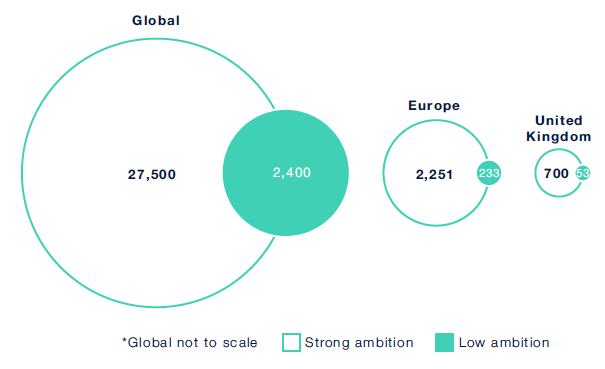
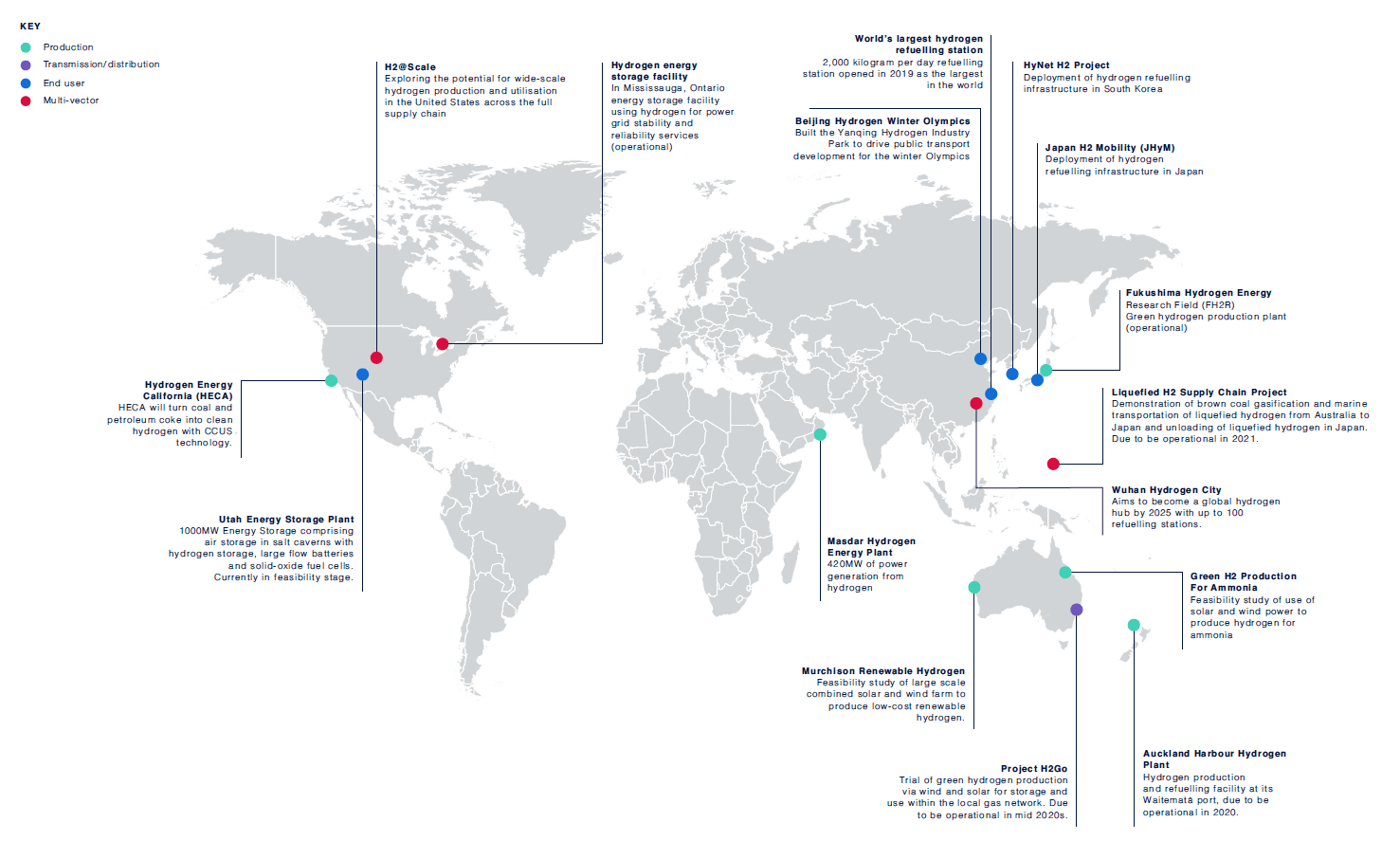
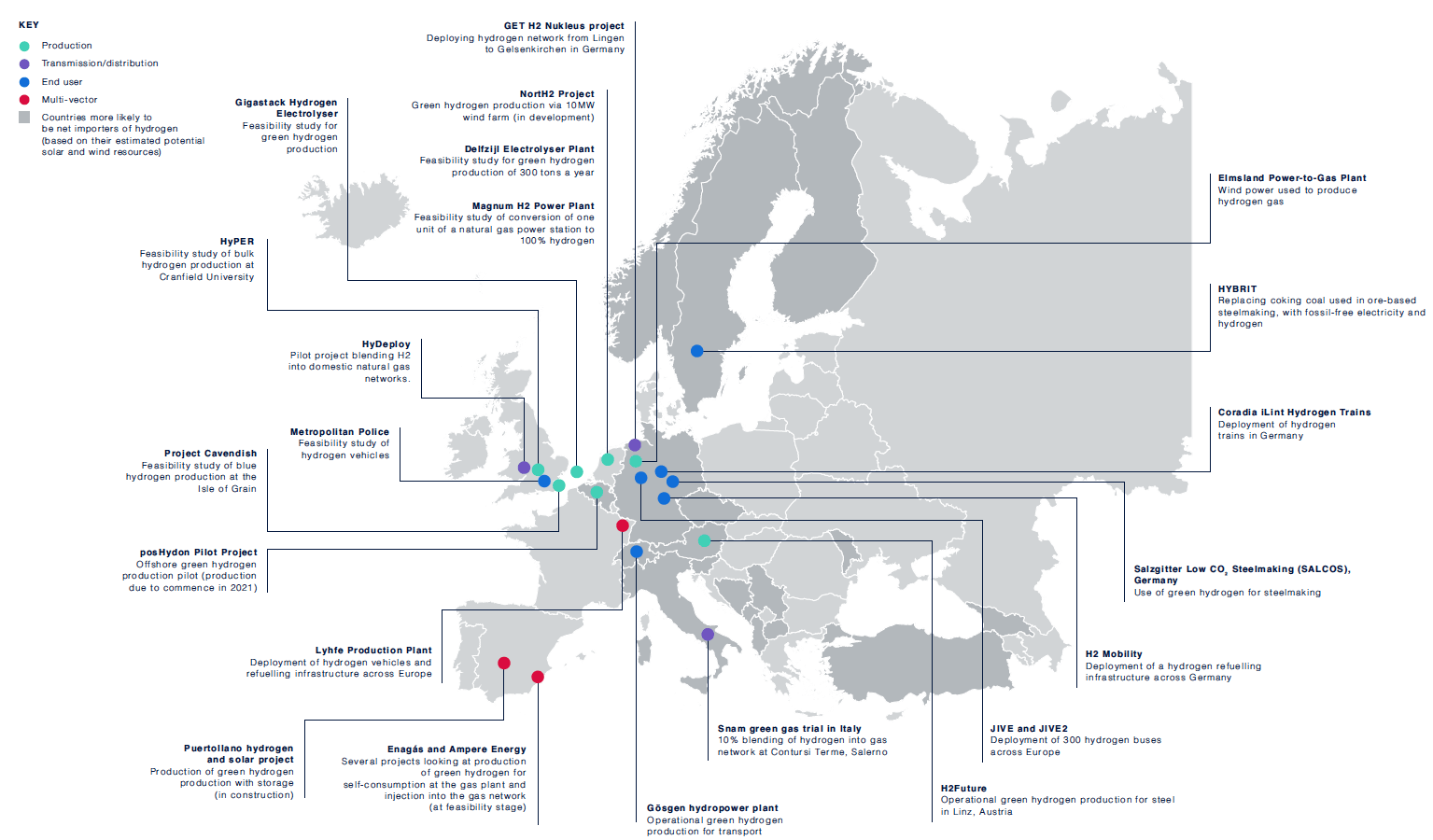
Case study: Germany's national hydrogen strategy
Germany's national hydrogen strategy[17] was approved by Ministers in June 2020. It highlights a focus on green hydrogen production and indicates Germany is set to be a large scale importer of hydrogen.
The strategy includes €7 bn to ramp up hydrogen technologies developing a "home market" and a further €2 bn to invest in large scale production plants in partner countries. It includes a target of generation plants with a total capacity of up to 5 gigawatt (GW), supplied by offshore and onshore renewable energy generation, by 2030. This corresponds to a green hydrogen production of up to 14 terawatt hours (TWh). The key aims of the strategy is:
- Assume global responsibility in emissions reductions by establishing hydrogen as a decarbonisation option.
- Make hydrogen competitive by pushing cost reductions into a fast-moving international market ramp-up.
- Develop a 'home market' to pave the way for imports.
- Establish hydrogen as an alternative energy carrier to decarbonise hard-to-abate sectors.
- Make hydrogen as a raw material for industry sustainable by switching current fossil fuel based production to renewable energy production.
- Enhance transport and distribution infrastructure using existing gas infrastructure and extending dedicated hydrogen networks or building new ones if required.
- Support research and train qualified personnel.
- Strengthen the German economy and secure global market opportunities for German companies.
- Understand global cooperation is an opportunity and establish international hydrogen markets, as sizeable imports will be required in medium and long term.
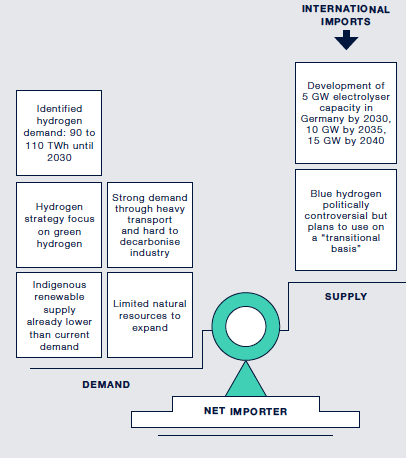
Case study: Australia's national hydrogen strategy
Australia agreed a National Hydrogen Strategy in November 2019[18]. The aim of the strategy is to position Australia firmly within a global hydrogen market by 2030. Australia plans to produce green hydrogen using its abundance of natural capital from wind and solar resources. The strategy highlights that Australia would be a net exporter to countries such as Japan and Korea, which are anticipated to be net importers.
Australia has taken an 'adaptive pathway' including two phases: a foundations and demonstrations phase (underway to 2025) and a large scale market activation phase (from 2025 onwards)[18]. The strategy outlines four key measures of success:
1. Australia being one of the top three hydrogen exporters to Asian markets.
2. Hydrogen providing economic benefits and jobs in Australia.
3. Australia having a robust, internationally accepted provenance certification scheme.
4. Australia demonstrating an excellent hydrogen related safety record.
The strategy includes a number of enabling actions[18]:
- A National Hydrogen Infrastructure Assessment which considers the hydrogen supply chain needs and is reviewed and updated at least every five years.
- Support pilot and trials for blending hydrogen in gas distribution networks.
- Plans to implement a recognised certification scheme to provide a guarantee to potential international importers of Australian hydrogen on the origin of that hydrogen (e.g. green hydrogen produced from solar).
- Bilateral partnerships to promote trade and investment in hydrogen.
- National coordination including an annual 'State of Hydrogen' report to be published by the Commonwealth Government.
"Scotland could make significant profit from exporting hydrogen to England and the rest of Europe"
Stakeholder questionnaire opinion
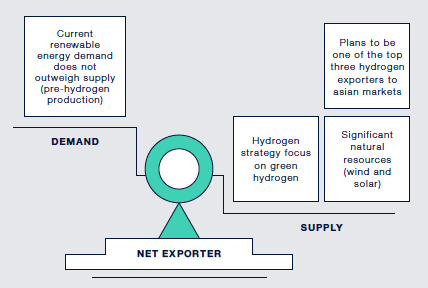
Contact
Email: onshoreoilandgas@gov.scot
There is a problem
Thanks for your feedback